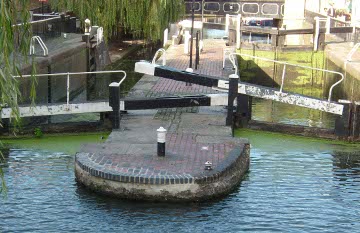BRITISH WATERWAYS has made a planning application to bolt a rubber fender to the lock structure to protect its botched brickwork on the unique Grade ll Listed locks on the Regents Canal at Camden Town, writes Del Brenner.
 It can be seen that part of the brick edge that is not repaired (right in the photo) is set inside the line of the original stone structure and does not get damaged by boats. However, the remainder of the brickwork edge sticks out further than the stone and is regularly clouted by boats as they nose into the lock. The bricks have frequently been dislodged, which is rather obvious.
It can be seen that part of the brick edge that is not repaired (right in the photo) is set inside the line of the original stone structure and does not get damaged by boats. However, the remainder of the brickwork edge sticks out further than the stone and is regularly clouted by boats as they nose into the lock. The bricks have frequently been dislodged, which is rather obvious.
Not heritage standard
When British Waterways carried out this latest crude repair, which is far from heritage standard, it did not think to realign the brick edge to sit inside the line of the stonework, and consequently it is not protected from boat impact.
The British Waterways clever solution to the problem is to spend more money on the cost of a large rubber fender and its installation by drilling bolts into the historic 200 year old stone structure to protect their brickwork. The outcome is depressing, and the final costs are not known.
Lack of pride
The brickwork on the nose of the lock island was laid some years ago, and each time the brick edge has been repaired British Waterways has failed to realign it. Also, one of the original pulley wheels is now missing.
The concrete slopped on the facing of the stonework will not be hidden by the fender at water level, and botched work will be there for all the world to see. Tens of thousands of visitors and tourists come to the markets at Camden Town every weekend, and many pass by the Hampstead Road Locks or walk over the horse bridge (Grade ll Listed) in front of the locks from where the photo was taken. British Waterways should be full of shame.
Poor level of maintenance
There are no fewer than seven Grade ll Listed canal buildings and structures around the wonderful large basin in Camden Town, and it has the greatest footfall of visitors on the network. You would have thought it might occur to British Waterways to take some trouble to keep it up to a good standard. But the level of maintenance is as poor as anywhere else and the lock gates still leak like sieves as reported in narrowboatworld some months ago. This treasured location could be British Waterways' pride and joy, but those are two words clearly missing from its lexicon.
A rare consultation
It is very welcome that in this instance British Waterways has applied for ‘listed' planning consent for the fender, which means that there is some sort of consultation process rather than it ploughing ahead. Years ago a planning application should have been made when the historic lock island was bricked over which might have resulted in a better job being done and the present problems avoided.
 The same applies to its work on the downstream end of the same listed Hampstead Road Locks where British Waterways boarded over the stone lock landing a while ago with B&Q style decking without a planning application. The photograph shows the deed being carried out. With a bit of consultation British Waterways could have been put right on that one as well, and a proper heritage job could have been the result. (Note that even then the lock gates were leaking and not being attended to.)
The same applies to its work on the downstream end of the same listed Hampstead Road Locks where British Waterways boarded over the stone lock landing a while ago with B&Q style decking without a planning application. The photograph shows the deed being carried out. With a bit of consultation British Waterways could have been put right on that one as well, and a proper heritage job could have been the result. (Note that even then the lock gates were leaking and not being attended to.)
Who knows best?
It makes sound sense for British Waterways to be more open, and the waterways would benefit greatly if everyone worked together. Perhaps British Waterways is often a bit wayward if it thinks that it always know best, and that it can avoid consultation which it sees as interference. Others see it as accountability.
Money for repairs and maintenance is so short that it is sad when we get poor results and too much is wasted, like the £250,000 down the spout with the unsuccessful ‘improvements' to the access ramp at City Road Locks.
Worse conflict
British Waterways got it so wrong that they had to change the design details at least three times, and did not even consult a neighbour whose property they were undermining. After a lot of fuss there is now a ramp with worse conflict between pedestrians and cyclists, and British Waterways have not replaced the three mature trees that they did not need to cut down.
More planning applications, more consultations, more listening on British Waterways' part would be well worth the effort, improve the quality and save money.
Any chance of seeing progress in the anxious and unsettled years to come?
